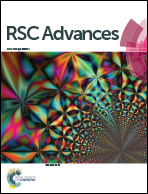Improving the efficiency of inverted organic solar cells by introducing ferrocenedicarboxylic acid between an ITO/ZnO interlayer†
Abstract
In this study, ferrocenedicarboxylic acid (FDA) has been introduced between an ITO electrode and ZnO interlayer to improve the performance of inverted polymer solar cells. The highest power conversion efficiency (PCE) of 9.06% is achieved among the measurements. Besides, the average PCE of FDA/ZnO based devices is observed with 11.9% enhancement (8.73% vs. 7.80%) compared to ZnO-only devices. Electrical characterization, surface morphology, wetting properties, as well as exciton generation rate and dissociation probability were investigated to understand the impact of FDA insertion on the interfacial properties. It was found that exciton dissociation efficiency and charge collection efficiency were significantly improved after inserting FDA, while the surface morphology, average roughness and water contact angle of the ZnO film were not changed. It was thought that FDA connected to the ITO electrode and ZnO film because of its carboxyl groups, which lead to a compact interfacial contact and reduced charge recombination. In addition, the devices based on the FDA/ZnO interlayers displayed improved stability in the argon-filled glove box without any encapsulation for about 1000 h compared to the ZnO-only devices. This study provides a new idea to introduce materials with functional groups between ITO/metal oxides interfaces to achieve more efficient charge collection and device performance.


 Please wait while we load your content...
Please wait while we load your content...